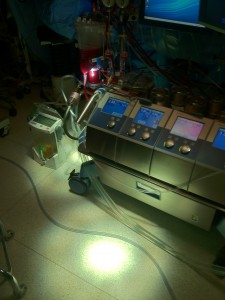Earlier this year, I visited Cedars-Sinai Medical Center to report a story for US News & World Report’s Best Hospitals issue. My assignment: meet heart patients, talk to surgeons, observe operations, and then write about it.

The first procedure I watched was an aortic valve replacement. The new, artificial valve was snaked up to the heart through the patient’s femoral artery. It was a tidy operation, done quickly and without complication.
The second procedure was a mitral valve repair. For this, the surgeon opted to use a surgical robot. After the patient’s heart was stopped and her blood safely pumping through the heart-lung machine (left), the surgeon stepped away from the operating table and sat down at a console. Viewing the heart in 3D, he slipped his fingers into the sensitive robotic controls through which he maneuvered remote tools at the operating table. On the OR monitor, I watched as the surgeon, via a set of robot arms, quite literally tugged and cut the patient’s heart strings (chordae tendineae), trimmed the oversized valve, and stitched it all up again.
Here’s a view from the robotic console:
Here’s a view from the table, robotic arms in motion:
The third surgery, a heart transplant, was harrowing to watch and frankly, difficult to stomach. The smells (a sawed-through sternum), sights (an empty chest cavity), and sounds (a beating heart plopped into a plastic bowl) made my knees weak. More than once, I had to sit down to take a deep breath.
During the procedure, I was surprised to see the patient’s heart still beating outside her body for about five minutes after it was removed.
Here’s a video of the beating heart soon after it was removed from the patient:
A few minutes after removal, slowing down:
All surgeries were successful. Patients recovered fully and without complications. If you’re interested in learning more about the patients and procedures, and seeing some amazing photographs by Daryl Peveto, I encourage you to read the story here.
